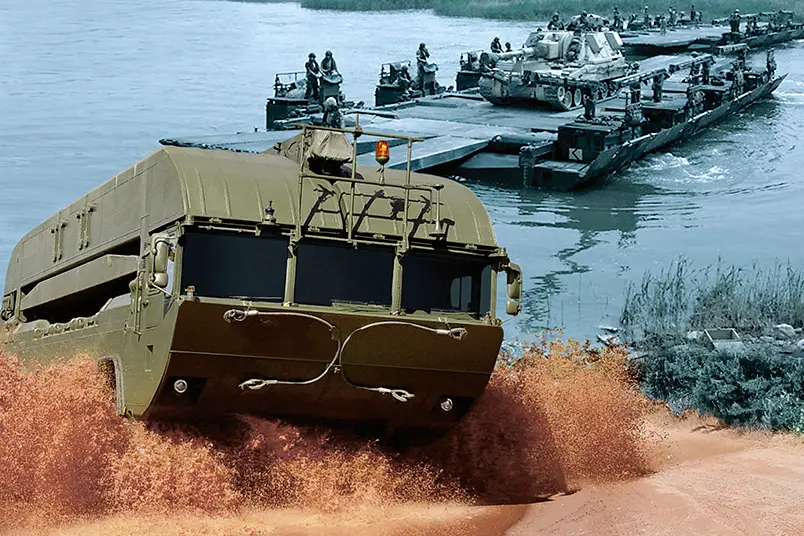M3 is the world’s most modern and fastest to deploy amphibious bridge and ferry system in terms of loading capacity, assembly time, and cross-country and in-water maneuverability. Originally developed by the German firm Eisenwerke Kaiserslautern (EWK, since 2002 acquired by General Dynamics European Land Systems), it succeeded the conceptually similar M2 made by the same company. It offers high mobility, availability and seamless land to water transition, and can be handled by a crew of just two soldiers. An increased level of system automation ensures low operating costs. Used as a bridge or as a multi-bay raft, the M3 can carry loads of up to MLC 85T/132W.

Whether used as bridge or as a ferry, the M3 provides state of the art loading capacity of up to MLC 85 (T) / 132 (W). The M3 can be crossed by all types of Main Battle Tank (MBT) including the Leopard 2, M1A2 Abrams or the Challenger 2. The M3 offers interoperability with other bridging solutions such as the SRB (Standard Ribbon Bridge)/FSB(Floating Support Bridge) and IRB (Improved Ribbon Bridge). We also offer coupling devices to ensure a correct interface at any time. That makes the M3 the right fit for coalitions which use different types of equipment but operate jointly. M3 has a simulator to help provide the right training and operational levels.

Like its predecessor, the M3 traverses roads on its four wheels, deploying two large aluminium pontoons for buoyancy on water. Development of the M3 began in 1982, with the final prototype being delivered 10 years later in 1992. A first order of 64 serial vehicles was made in 1994, and it entered service with the German and British armies in 1996. Since then, the M3 has also been adopted by the armies of the Republic of China (Taiwan) and Singapore. An upgraded version, known in some circles as the M3G, is in service with the ROC and Singapore armies. This version features an armoured cabin, NBC protection, an air conditioning system and a special tropical kit.

The M3 is self-deployable by road, operating as a 4×4 wheeled vehicle with a maximum road speed of 80 km/h. In water, the M3 is propelled and steered by 2 fully traversable pump jets at speeds of up to 14 km/h.Multiple rigs may be joined by long connectors called “ramps”, 4 of which are carried on each vehicle, to form a bridge across a water obstacle. 8 M3 Rigs will bridge a 100m water gap this way, and can be traversed by vehicles up to and including the heaviest 60+ ton main battle tank like the Leopard 2A6 and Challenger 2. Alternatively, just 2 Rigs may be joined to create a ferry capable of carrying a similar load across much wider water gaps. 3 Rigs joined together may carry up to the equivalent of 2 such MBTs.

The M3 Amphibious Bridging Vehicle saw its first combat actions in Operation Telic, Britain’s military operations in the Iraq War. From 25 March 2003, 412 Troop(V),23 Amphibious Engineer Squadron, of 28 Engineer Regiment of the Royal Engineers ferried elements of 3 Commando Brigade across the Shatt Al-Basrah waterway, enabling their continued advance on the Iraqi city of Basra. During the NATO Anakonda 2016 exercises a combined German and British Army engineer unit operated the longest M3 floating bridge ever assembled. The 350 m long bridge of 8 British and 22 German units was put together in only 35 minutes, enabling NATO forces to cross the Vistula River in Poland. The exercise was designed to strengthen military cooperation, cohesion and interoperability within NATO and its partner nations.















